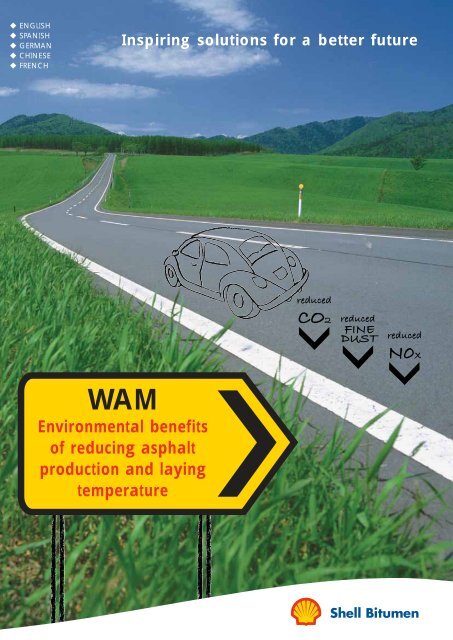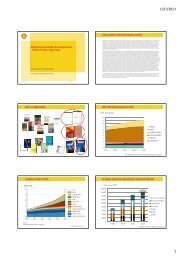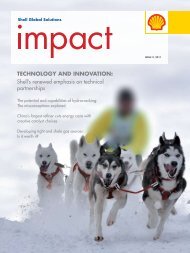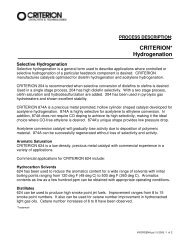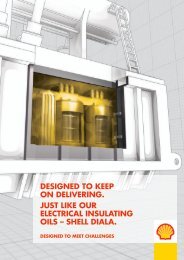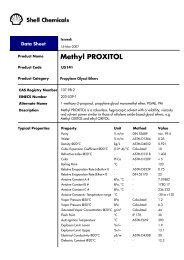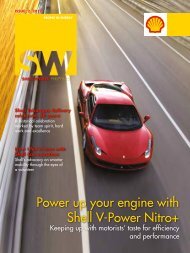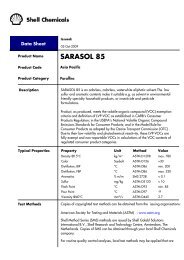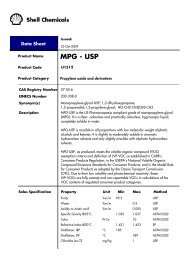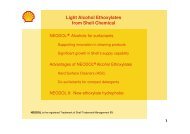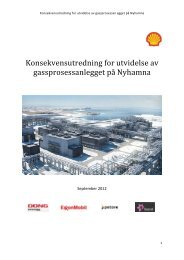Shell Bitumen - WAM Field Test Results Italy - Inspiring Solutions for ...
Shell Bitumen - WAM Field Test Results Italy - Inspiring Solutions for ...
Shell Bitumen - WAM Field Test Results Italy - Inspiring Solutions for ...
You also want an ePaper? Increase the reach of your titles
YUMPU automatically turns print PDFs into web optimized ePapers that Google loves.
ENGLISH<br />
SPANISH<br />
GERMAN<br />
CHINESE<br />
FRENCH<br />
<strong>Inspiring</strong> solutions <strong>for</strong> a better future<br />
<strong>WAM</strong><br />
Environmental benefits<br />
of reducing asphalt<br />
production and laying<br />
temperature
Emission and occupational exposure at lower asphalt production and laying<br />
temperatures<br />
M. Lecomte<br />
<strong>Shell</strong> <strong>Bitumen</strong>, 307 rue d’Estienne d’Orves, 92708 Colombes, Paris, France<br />
F. Deygout<br />
<strong>Shell</strong> <strong>Bitumen</strong>, RD3, BP97, 76650 Petit Couronne, France<br />
A. Menetti<br />
Contech, <strong>Italy</strong><br />
Summary<br />
It is well known that reducing asphalt production temperatures has significant<br />
environmental benefits on emissions, occupational exposures and energy<br />
consumption. The hot mix asphalt industry has been aware of this <strong>for</strong> many years.<br />
The biggest challenge however has always been to achieve adequate asphalt<br />
mixture quality at lower or ambient operating temperatures.<br />
In recent years, new production processes at temperatures between 80 - 120°C have<br />
attracted much interest because of the possibility to approach or even obtain hot mix<br />
quality and having reductions in energy consumption, emissions and occupational<br />
exposures. <strong>Results</strong> of recent measurements on a site in Florence in <strong>Italy</strong> show that<br />
decrease in temperature offers a dramatic reduction in greenhouse gases emission<br />
and a considerable reduction of fume emissions and workers exposure, together with<br />
a 30% energy reduction. This confirms the great potential of this solution <strong>for</strong> the<br />
environment.<br />
1. Introduction<br />
<strong>Shell</strong> <strong>Bitumen</strong> is very active in the development of new technologies and in<br />
investigations to properly quantify the environmental benefits [1-5].<br />
This paper describes the results of recent emission and exposure studies carried out<br />
at Conglobit during the production of their new asphalt mixture, Greenfalt,<br />
manufactured at low temperatures and developed on the basis of the <strong>Shell</strong> patented<br />
warm asphalt mixture (<strong>WAM</strong>) technology 1 using foam [6]. It must be understood that<br />
in all cases (hot and warm production) the values determined are well below any<br />
occupational exposure or environmental limit. This clearly demonstrates that both hot<br />
mix and <strong>WAM</strong> Foam production are fully acceptable from an occupational and<br />
environmental point of view.<br />
In October 2006, during a trial on the high speed road Firenze-Pisa-Livorno in <strong>Italy</strong>,<br />
several air pollutants (CO 2 , CO, NO x , SO 2 , TOC and dust) emitted by the chimney of<br />
the mixing plant were measured by Det Norske Veritas AS. Simultaneously, emission<br />
measurements were carried out at three positions in the asphalt mixing plant. During<br />
the asphalt laying and compaction operations, the paving crew was equipped with<br />
fume collection devices <strong>for</strong> exposure measurements.<br />
1<br />
<strong>WAM</strong> is a <strong>Shell</strong> trademark<br />
1/11
For both emissions and exposures, fume analysis was per<strong>for</strong>med to determine the<br />
total aerosols, the organic aerosols (Benzene Soluble Fraction), the gaseous fraction<br />
and specific polycyclic aromatic compounds.<br />
All measurements were per<strong>for</strong>med during the production of the conventional hot<br />
mixtures and the production of Greenfalt. The mixing temperatures were 180°C <strong>for</strong><br />
the conventional hot mixture and 120 to 125 °C <strong>for</strong> the <strong>WAM</strong> Foam. The productions<br />
were carried out on different days of the same week, in the same mixing plant, with<br />
the same testing devices and in similar weather conditions in order to get a set of<br />
fully comparable data. In addition, energy consumptions <strong>for</strong> the two different<br />
productions were compared.<br />
2. Studies in Florence, <strong>Italy</strong><br />
Work was conducted on 25 and 27 October 2006 in Florence at a mixing plant that<br />
was modified to produce asphalt according to the <strong>WAM</strong> foam process. The hard<br />
bitumen used <strong>for</strong> <strong>WAM</strong> was a 20/30 pen grade (EN12591 – Table 1) and the soft<br />
bitumen was a V10000 grade (EN12591 – Table 3). The objectives of the study were<br />
the following:<br />
To determine personal exposures <strong>for</strong> applications <strong>for</strong> the road contractor<br />
Conglobit. Conglobit uses the <strong>WAM</strong> Foam process to produce and lay asphalt<br />
mixtures under the name "Greenfalt".<br />
To compare, under field exposure conditions, the type of emissions using<br />
Greenfalt with those using HMA.<br />
To collect and compare emission values from mixing operations in the asphalt<br />
plant during <strong>WAM</strong> and HMA production.<br />
Exposures to particulate matter were determined and compared with Italian<br />
Occupational Exposure Limits (OEL) <strong>for</strong> bitumen fumes (petroleum bitumen CAS<br />
number 8052-42-4). Some countries, such as <strong>Italy</strong> in 2003, have adopted the<br />
American Conference of Governmental Industrial Hygienists (ACGIH)<br />
recommendations [7] into national legislation. In January 2000, ACGIH changed its<br />
Recommended Exposure Limits (REL) <strong>for</strong> bitumen fumes. The limit was 5 mg/m 3<br />
measured as total aerosols (mineral and organic). The latest REL is 0.5 mg/m 3<br />
measured as benzene-soluble aerosol of the inhalable fraction, i.e. the organic<br />
fraction of total aerosols.<br />
Total aerosols are measured using a closed-faced 37-mm cassette equipped with a<br />
PTFE filter, which is a "total aerosol" sampler (breathable fraction). Total organic<br />
aerosols are then extracted and quantified (Benzene Soluble Fraction or BSF). Note<br />
that the inhalable fraction is regarded as similar to BSF <strong>for</strong> this work.<br />
Sampling durations <strong>for</strong> HMA and <strong>WAM</strong> were between 3 and 4 hours which was<br />
adapted to obtain more than the minimum quantity (BSF > 0.1 mg/m 3 ) required by<br />
NIOSH 5042.<br />
The positions of the samplers are indicated in Picture 1.<br />
Two samplers close to the pugmill; due to the observed saturation of the filters<br />
in the case of hot mixture production, a third filter was added with a 60 minutes<br />
sampling time. No saturation was observed in the case of <strong>WAM</strong> Foam.<br />
Two samplers set up at the top of the discharge hoppers.<br />
Sampler(s) at the discharge point.<br />
Static sampler, about 50 m away from the mixing plant.<br />
2/11
Picture 1 Emission samplers in the asphalt plant<br />
2.2 Conditions and measurements at the asphalt plant<br />
On 26 October, paving work involved the construction of a structural layer using<br />
Greenfalt. An amount of 870 tons of Greenfalt were laid on the site with a length of<br />
1300 m, 3.5 m width and thicknesses were 90, 50 and 90 mm <strong>for</strong> the three sections<br />
of this layer.<br />
Recorded air temperatures were 19°C in the morning and 30°C at 3 pm in the<br />
afternoon. Weather condition was cloudy with no wind. Paving crew sampling<br />
duration was around 400 minutes.<br />
Sampling <strong>for</strong> exposure measurements was per<strong>for</strong>med <strong>for</strong> the following jobs:<br />
A paver driver<br />
Two screedmen<br />
A skilled labourer / raker<br />
A roller compactor driver<br />
Personal pumps were used <strong>for</strong> fume sampling with a 2 l/min flow rate. The matter<br />
was collected on PTFE filters (2 µm) placed in the standard 37-mm cassette (see<br />
pictures 2 and 3):<br />
<br />
<br />
Total aerosols, which represents the mineral and organic aerosols<br />
BSF extracted from the filter with benzene, which represents the total organic<br />
aerosols (the remaining part is regarded as the mineral fraction or MF)<br />
3/11
Picture 2 Picture 3<br />
Two static samples were also taken in order to cover the whole worksite area on the<br />
road and to check whether there were aerosol sources other than the laying train.<br />
During the whole day of sampling, the absence of fumes (visual and smell) during<br />
laying of the warm asphalt mixture has to be noted (Picture 4). Only a little water<br />
vapour was observed from water used <strong>for</strong> the roller (compactor).<br />
Picture 4<br />
The standard 37-mm filter cassettes containing PTFE were used in series with<br />
adsorbent tubes in order to collect the vapour fraction (gases). The suitable<br />
adsorbent used <strong>for</strong> trapping volatile compounds is XAD-2 with front and back<br />
adsorbent sections. The front and back sections were separately extracted using<br />
dichloromethane to check <strong>for</strong> breakthrough. Analysis and quantifications were<br />
per<strong>for</strong>med by means of gas chromatography with flame ionisation detection (GC-<br />
FID).<br />
Sampling and analysis were carried out in accordance with NIOSH 5042 NMAM (MF<br />
& BSF using 37 mm samplers) with some minor changes.<br />
Polycyclic Aromatic Hydrocarbon (PAH) determination and quantification in the<br />
benzene-soluble fractions were conducted on the HMA samplers. This has not been<br />
done in the case of <strong>WAM</strong> as the amount of collected organic matter was too low <strong>for</strong><br />
such analysis. The compound identification is based on the priority 16 compounds<br />
mentioned in the US EPA (Environmental Protection Agency) list. PAH analysis was<br />
4/11
carried out in accordance with <strong>Shell</strong>’s in-house AMS 1057-1 method (based on the<br />
610-EPA method <strong>for</strong> wastewater). PAHs were extracted with THF from the organic<br />
part of the collected particulates (BSF) and analysed by HPLC-UV.<br />
3. <strong>Results</strong> and discussion on measurements in the asphalt plant<br />
3.1 <strong>Results</strong> on fuel consumption in the asphalt plant<br />
The fuel (gas) consumption was measured at different levels of the plant’s production<br />
capacity in the range from 60-100 %. The results showed a reduction in fuel<br />
consumption of 35%.<br />
3.2 <strong>Results</strong> gas and dust emissions from the chimney<br />
During the asphalt production <strong>for</strong> the paving work on the high speed road Firenze-<br />
Pisa-Livorno in <strong>Italy</strong>, several air pollutants (CO 2 , CO, NO x , SO 2 , TOC and dust)<br />
emitted by the chimney of the mixing plant were measured by Det Norske Veritas AS.<br />
An impression of the set-up is shown in Pictures 5 and 6.<br />
Picture 5 Picture 6<br />
The results obtained at a production rate of 140 tonnes asphalt per hour are<br />
presented in Figures 1, 2 and 3. Lowering the operating temperatures from 180 °C in<br />
the hot mixture production to about 125-130°C in the warm asphalt mixture<br />
production produced a considerable reduction in the amount of gas and dust<br />
emissions.<br />
5/11
Figure 1 CO 2 emission levels at three measurement times in the asphalt plant<br />
5<br />
4.5<br />
M1 M2 M3<br />
4<br />
Emission level (tonnes/h)<br />
3.5<br />
3<br />
2.5<br />
2<br />
1.5<br />
1<br />
0.5<br />
0<br />
HMA<br />
CO2, t/h<br />
<strong>WAM</strong> foam<br />
In Figure 1 the CO 2 emission is shown in tonne per hour and emission reduction<br />
obtained is about 35%.<br />
Figure 2 CO and NO x emission levels at three measurement times in the asphalt<br />
plant<br />
8<br />
7<br />
M1 M2 M3<br />
6<br />
Emission level (kg/h)<br />
5<br />
4<br />
3<br />
2<br />
1<br />
0<br />
HMA <strong>WAM</strong> foam HMA <strong>WAM</strong> foam<br />
CO, kg/h<br />
NOx, kg/h<br />
Figure 2 shows that the CO reductions obtained were about 8% and the NO x<br />
reduction was about 60%.<br />
6/11
Figure 3 SO 2 and dust emission levels at three measurement times in the asphalt<br />
plant<br />
0.1<br />
0.09<br />
M1 M2 M3<br />
0.08<br />
Emission level (kg/h)<br />
0.07<br />
0.06<br />
0.05<br />
0.04<br />
0.03<br />
0.02<br />
0.01<br />
0<br />
HMA <strong>WAM</strong> foam HMA <strong>WAM</strong> foam<br />
SO2, kg/h<br />
Dust, kg/h<br />
Figure 3 shows that SO 2 and dust emissions levels are low, but still reductions in the<br />
order of 25 to 30% can be obtained.<br />
7/11
3.3 <strong>Results</strong> and discussion on emissions in the asphalt plant<br />
A first emission study was carried out in an asphalt mixing plant in 2000 [2]. This<br />
recent study is a more extensive study in an asphalt mixing plant. The results (in<br />
mg/m 3 ) are presented in Figure 4, in which MF indicates the mineral fraction, BSF the<br />
benzene soluble fraction and VF the volatile fraction.<br />
Figure 4 Emissions in the asphalt plant<br />
Pugmill sampler 1 Pugmill sampler 2 Hopper<br />
70<br />
Emissions (mg/m3)<br />
60<br />
50<br />
40<br />
30<br />
20<br />
10<br />
0<br />
HMA <strong>WAM</strong> HMA <strong>WAM</strong> HMA <strong>WAM</strong><br />
MF BSF VF<br />
It appears that the pugmill discharge is the location where most fumes are<br />
emitted.<br />
The mineral fraction (MF) was found similar.<br />
The organic fraction (BSF) was found significantly higher <strong>for</strong> HMA (up to 200<br />
times more). Organic aerosols represent a little part of the total emissions <strong>for</strong><br />
<strong>WAM</strong> unlike HMA (up to 4% and 90% respectively).<br />
The volatile fraction (VF) was found higher <strong>for</strong> HMA (up to 6 times more). Due to<br />
the very low level of emitted BSF with <strong>WAM</strong>, the volatile fractions can represent<br />
almost all the organic emissions (up to 99%).<br />
8/11
4. <strong>Results</strong> and discussion on the exposure measurements on the paving site<br />
The exposure values (corrected <strong>for</strong> field blank) are given in Table 1. There are 8-hour<br />
Time-Weighted Average values (TWA). The 8-hr TWA values correspond to average<br />
exposure over the course of an 8-hour work shift. This value is often preferred<br />
because it is more representative of a full workday.<br />
Table 1<br />
8 h TWA in mg/m 3 <strong>WAM</strong> laying (day 2)<br />
MF BSF SV<br />
Paver driver 0.22 0.05 3.45<br />
Screedman 1 0.19 0.08 2.40<br />
Screedman 2 0.19 0.07 1.18<br />
Raker 0.16 0.14 2.93<br />
Roller driver 0.13 0.03 0.79<br />
Static 1 0.97 0.02 0.32<br />
Static 2 0.14 0.01 0.23<br />
The main part of the aerosols is inorganic (mineral dust). Relevant exposure data<br />
(BSF) have been compared with Italian OELs. On an 8-hr Time-Weighted Average<br />
basis, no measured values exceed these OELs.<br />
It must be understood that in all cases (hot and warm production) the values<br />
determined are well below any occupational exposure or environmental limit. This<br />
clearly demonstrates that both hot mixture and <strong>WAM</strong>-Foam production are fully<br />
acceptable from an occupational and environmental point of view.<br />
When compared with <strong>Shell</strong>’s previous exposure measurements conducted on paving<br />
HMA, these emissions are in the lower range (commonly 0.05-0.60 mg/m 3 in BSF).<br />
The same level of magnitude (< 0.05) was previously recorded when using usual pen<br />
grade binders (e.g. 35/50) at around 150°C.<br />
The BSF data are also consistent with exposure data from our earlier studies (up to<br />
0.05 mg/m 3 ).<br />
Static values were found rather high especially in terms of mineral dust. This is<br />
probably explained by the traffic on the other side of the motorway.<br />
9/11
5. PAHs in BSF<br />
The PAH concentrations are the summed values <strong>for</strong> both BSFs and VFs. The<br />
analysis results are presented in Figure 5 and the values are expressed in ng/m 3 .<br />
The sum of the 4-6 ring compounds and the sum of 15 detected PAHs are displayed.<br />
The results are consistent with the BSF values: the higher the organic fraction, the<br />
higher the PAH content is. The values <strong>for</strong> the hot mixture presented in Figure 5 are<br />
typical values derived from previous exposure measurements carried out by <strong>Shell</strong>.<br />
Figure 5<br />
Paver driver Screedman Raker Roller driver<br />
PAH emissions (ng/m3)<br />
900<br />
600<br />
300<br />
0<br />
HMA <strong>WAM</strong> (< 0.1) HMA <strong>WAM</strong> (< 2)<br />
4 - 6 ring Total (15 PAHs)<br />
6. Concluding remarks<br />
In the asphalt production, the <strong>WAM</strong> Foam technology is significantly more<br />
environmentally friendly in terms of emissions of CO 2 , NO x , dust and organic aerosol.<br />
The organic aerosols, expressed in benzene soluble fraction, emitted with <strong>WAM</strong> at<br />
around 125°C are in the lower range commonly found <strong>for</strong> hot asphalt laying when<br />
good product stewardship is used (e.g. the use of lowest recommended<br />
temperature). This is in accordance with a previous <strong>Shell</strong> <strong>Bitumen</strong> paper, which<br />
demonstrates that in the temperature range relevant <strong>for</strong> paving applications (about<br />
140 to 190°C), the fume emission rate increases by a factor of 2 <strong>for</strong> about every 12°C<br />
increase in temperature [8].<br />
10/11
References<br />
1. B.G. Koenders, D.A. Stoker, C. Bowen, P. de Groot, O. Larsen, D. Hardy, K.P.<br />
Wilms, Innovative process in asphalt production and application to obtain lower<br />
operating temperatures, 2 nd Eurasphalt&Eurobitume congress, Barcelona, 20-22<br />
September 2000, Book 2, session 3, pp. 831-840.<br />
2. P.C. de Groot, C. Bowen, B.G. Koenders, D.A. Stoker, O. Larsen, J. Johansen, A<br />
comparison of emissions from hot mixture and warm asphalt mixture production,<br />
Proceedings IRF congress, Paris, June 2001, paper O022.<br />
3. B.G. Koenders, D.A. Stoker, C. Robertus, O. Larsen and J. Johansen, <strong>WAM</strong><br />
Foam, asphalt production at lower operating temperatures, 9 th International<br />
Conference on Asphalt Pavements, ISAP 2002.<br />
4. D. Strickland, Development of <strong>WAM</strong> Foam technology, paper presented at 2 nd<br />
International Conference: “Addressing Government sustainability and recycling<br />
targets <strong>for</strong> contruction and related industries, John Moores University, Liverpool,<br />
February 2003, UK.<br />
5. O.R. Larsen, Ø. Moen, C. Robertus, B.G. Koenders, <strong>WAM</strong> Foam asphalt<br />
production at lower operating temperatures as an environmental friendly<br />
alternative to HMA, 3 rd Eurasphalt&Eurobitume congress, Vienna, 2004.<br />
6. European patent numbers: EP 863 949, EP 977 813 and EP 1 263 885.<br />
7. American Conference of Governmental Industrial Hygienists 2001 TLVs and BEIs<br />
booklet.<br />
8. Brandt, H. C. A. and De Groot, P. C.; A laboratory rig <strong>for</strong> studying aspects of<br />
worker exposure to bitumen fumes; American Industrial Hygiene Association<br />
Journal (1999), 60(2), 182-190.<br />
11/11


